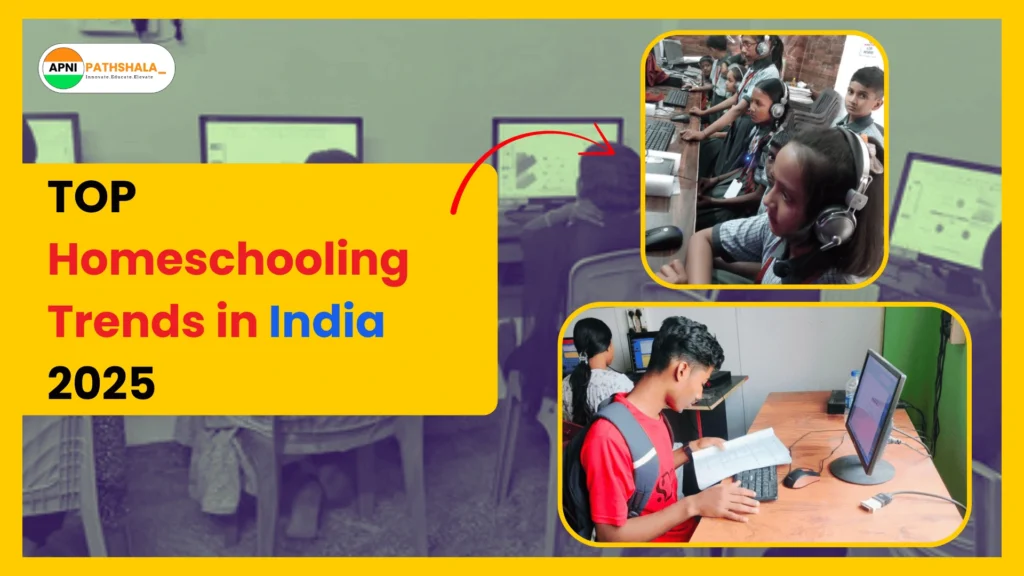Top Homeschooling Trends in India I 2025

A quick question for you. When you hear the word “homeschooling,” do you still picture kids sitting at the dining table with a pile of books while parents try to be teachers? Well, things have changed. A lot. In 2025, homeschooling is not just about staying at home. It’s about using smart tools like AI, and learning in a way that actually suits your child and not the other way around. Kids are learning at their own speed, choosing topics they enjoy, and getting help from technology that understands what they need. It’s like having a personal classroom that’s built just for them. If you’re a parent thinking about homeschooling, already doing it, or just curious about what’s new, this blog is for you. Let’s look at what’s trending in homeschooling right now, and how you can make the most of it for your child. 1. Artificial Intelligence in Homeschooling You’ve probably heard the word “AI” so many times, it feels like the most overhyped word. But when it comes to homeschooling, AI is not hype, it’s help. And it’s changing how Indian children learn at home. How is AI being used in homeschooling? Instead of giving your child the same worksheet as every other kid, AI lets them learn at their own pace, in their own way. It’s not about replacing parents or teachers. It’s about supporting them, so the learning feels personal and progress is clear. Why do parents love this? 2. Mobile-First Learning Here’s the truth: Not every homeschooling family in India can afford laptops, fancy setups, or high-speed Wi-Fi. But, this does not have to be a roadblock in a child’s education. This is because from rural India to the urban one, almost everyone has a smartphone. Plus, there are a lot of government initiatives where smartphones are regularly distributed to the needy ones. And in 2025, that’s enough. How can you use it? Whether you’re in Delhi or a small town anywhere else, your child can now access quality content using just a smartphone. And parents are loving this shift because it’s: Mobile-first learning is a big reason why homeschooling is becoming more practical across India, not just for the elite. 3. Personalized Learning Plans This isn’t about using high-end tech. This is about changing how we think about learning. Today, more Indian parents are ditching “fixed” timetables and standard textbooks in favor of personalised learning, because every child learns differently. What does this look like? Let’s say your child is strong in math but struggles with writing. You don’t need to spend equal time on both. Focus more on writing, and let them move faster in math. That’s the beauty of personalised learning, it’s efficient and child-focused. How are parents doing it? In short, you become the architect of your child’s education. And it works. Want a testimonial? 4. Hybrid Homeschooling Full-time homeschooling is a big step. Some parents want flexibility, but also the structure of school. That’s where hybrid homeschooling is becoming popular in Indian cities. What is Hybrid Homeschooling? Hybrid homeschooling is a flexible approach that blends the structure of traditional schooling with the freedom of homeschooling. Instead of choosing between full-time school or full-time homeschool, you can do both on your own terms. Here’s how hybrid homeschooling works in 2025: Why are Indian families loving hybrid homeschooling? Many schools are even open to flexible attendance now, especially after COVID. Parents all over are creating hybrid learning schedules that balance academics, hobbies, and emotional health. And the results? Children are more relaxed, more focused, and more curious. Read this story of Lakshya, a seven year old who builds robots and is getting homeschooled by his father. 5. Community-Based Microschools This is one of the most heartwarming homeschooling trends in 2025. Instead of sending kids to a big school, families in the same apartment, neighbourhood, or society are starting microschools. Think of it as a mini school run by parents and local facilitators. What does a microschool look like? Imagine 5 to 15 kids of different age groups, learning together like in a big joint family. There are no rigid time tables or heavy textbooks. Learning happens through hands-on activities, meaningful discussions, curiosity-led projects, and real-life experiences. Often, these kids are taught not by certified teachers, but by parents, freelancers, retired educators, or even college students who are passionate about a subject. Some bring in local artists or science communicators. Others take kids on field visits to farms, libraries, or even nearby construction sites to understand how the real world works. Why is this trend catching on in 2025? If you’re exploring homeschooling in 2025, just know, you’re not the only one figuring it out. From AI tools to small learning pods, families across India are rewriting the rules. It’s not always easy. But it’s real. It’s personal. And it’s working. At ApniPathshala, we’re walking this journey with you. We help learning pods get the basics like personal PCs and guidance, so kids can actually thrive, not just study. If you’re starting something, or even thinking about it, we’d love to help.
